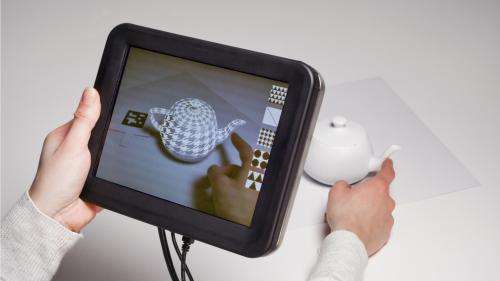Disney researchers add sense of touch to augmented reality applications (w/ Video)

Technology developed by Disney Research, Pittsburgh, makes it possible to change the feel of real-world surfaces and objects, including touch-screens, walls, furniture, wooden or plastic objects, without requiring users to wear special gloves or use force-feedback devices. Surfaces are not altered with actuators and require little if any instrumentation.
Instead, Disney researchers employ a newly discovered physical phenomenon called reverse electrovibration to create the illusion of changing textures as the user's fingers sweep across a surface. A weak electrical signal, which can be applied imperceptibly anywhere on the user's body, creates an oscillating electrical field around the user's fingers that is responsible for the tactile feedback.
The technology, called REVEL, could be used to create "please touch" museum displays, add haptic feedback to games, apply texture to projected images on surfaces of any size and shape, provide customized directions on walls for people with visual disabilities and enhance other applications of augmented reality.
"Augmented reality to date has focused primarily on visual and auditory feedback, but less on the sense of touch," said Olivier Bau, a postdoc at Disney Research, Pittsburgh. "Sight and sound are important, but we believe the addition of touch can create a really unique and magical experience."
The research findings by Bau and Ivan Poupyrev, a senior research scientist at Disney Research, Pittsburgh, will be presented Aug. 8 at the SIGGRAPH 2012, the International Conference on Computer Graphics and Interactive Techniques at the Los Angeles Convention Center. It also will be demonstrated for attendees of SIGGRAPH Emerging Technologies Aug. 5-9.
The electrovibration effect was first reported in 1953. It's a sensation that people sometimes feel when they slide a finger across a smooth metal surface of an ungrounded electrical appliance, such an older model of toaster. With the dry, outer layer of skin serving as an insulator, a small alternating current applied to the conductive metal surface can generate an attractive force between the surface and a small electrical charge induced in the fluids of the finger's deeper tissues as the finger moves across the surface. No current actually passes through the skin and the amount of induced charge is negligible, but it results in a perception that the surface is rubbery.
Bau and Poupyrev discovered that the same sensation could be created by applying the small alternating current anywhere on the user's body instead of the surface — reverse electrovibration.
By tracking the finger's position using an external sensor, such as a Microsoft Kinect, the researchers can manipulate the electrovibration to make the user feel bumps, edges or changes in texture corresponding to particular locations on the surface.
"The amount of current used is extremely low — in the microampere range," Poupyrev said. "The static electric spark we feel when touching a doorknob, by comparison, is a higher current and, even so, presents no health and safety concerns."
The surfaces themselves require no extensive modification, though they need to be coated with an insulator-covered electrode, or "REVEL skin." Anodized aluminum objects or capacitive touch-screens can be used without any modification, while a REVEL skin can be manufactured on walls or other surfaces using off-the-shelf materials. One simple method is to coat a surface with a conductive paint and add a coat of conventional household paint as an insulating layer. The surfaces must also share a common electrical ground with the REVEL signal generator.
Two years ago, Bau, Poupyrev and other Disney researchers used the electrovibration effect to create touch pads for smartphones and tablet computers that provided tactile feedback. But by employing reverse electrovibration, REVEL scales up much more readily for use on almost any object or surface anywhere in the environment, opening up a wide variety of possible tactile feedback applications, Bau said.
Disney Research lab associates Mathieu LeGoc and Laureline Galliot and research associate Matthew Glisson were involved in developing an interactive installation using REVEL that will be on display at SIGGRAPH.
More information: For a copy of the research paper, please visit the project website at http://www.disneyresearch.com/research/projects/hci_revel_drp.htm.
Provided by Disney Research

















